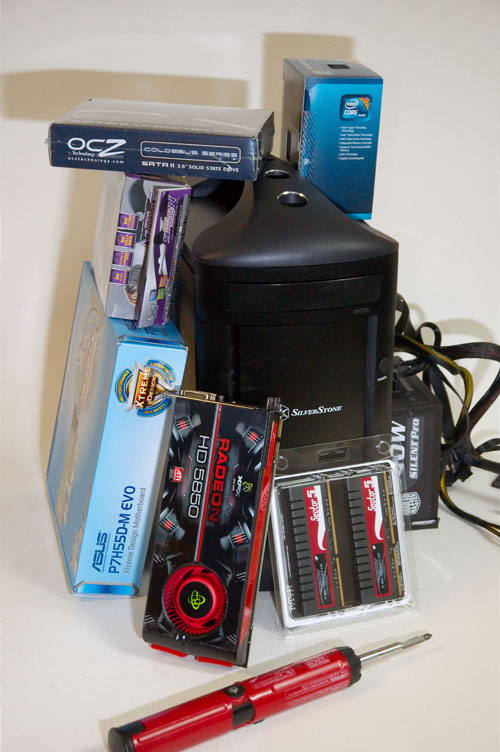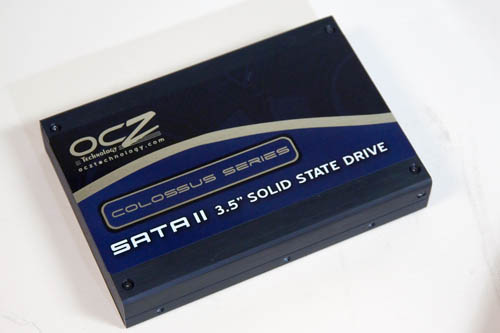The Components
Bear in mind that this system is an experimental build. So you’ll get to go along for the full ride, including all the gotchas and warts I encountered. Sometimes you learn more from the mistakes and glitches than if everything went smoothly.
First, cost was no object. That didn’t mean I had a bottomless budget, but it did mean I wasn’t going to skimp on components. The goals for the system were pretty simple:
- Low power usage at idle
- Good gaming performance
- Very quiet
- Relatively small. It would be something you could lug around to LAN parties.

Let’s check out the component list.
|
Component |
Brand / Model |
Cost |
|
CPU |
Intel Core i5 661 |
$205 |
|
Motherboard |
Asus P7H55D-M EVO |
$135 |
|
CPU Cooler |
Scyther Big Shuriken Low |
$ 35 |
|
Memory |
4GB Patriot Viper II Sector 5 DDR3-1600 |
$110 |
|
Graphics Card |
XFX Radeon HD 5850 |
$299 |
|
Hard Drive |
OCZ Colossus 250GB 3.5” SSD |
$849 |
|
Optical Drive |
Asus BC-08B1ST Blu-ray combo drive |
$110 |
|
PSU |
Cooler Master Silent Plus Pro 500W |
$100 |
|
Case |
Silverstone SG04B-FH |
$159 |
|
OS |
Windows 7 Home Premium OEM x64 |
$105 |
|
Total |
|
$2,107 |
That’s over $2,100 for a dual core gaming rig. Of course, for the $850 cost of the SSD, you could practically build a new system. But we’re in the pursuit of knowledge here, so damn the cost and full speed ahead.











81 Comments
View All Comments
stromgald30 - Wednesday, January 27, 2010 - link
Isn't there a price premium for going to mITX? I know mATX tends to be cheaper overall (system-wise) when compared to ATX, but my feeling has been that mITX is generally more expensive, despite being smaller/less capable for expansion.Of course with the recent increase in mITX over the past few years, my gut could be wrong.
Mr Perfect - Wednesday, January 27, 2010 - link
It used to be. Two years ago the only decent MITX boards with x16 slots where $300-$400 monsters from companies that specialized in embeded and industrial computers.Recently, Zotac had a very popular LGA775 board(http://www.newegg.com/Product/Product.aspx?Item=N8...">http://www.newegg.com/Product/Product.aspx?Item=N8..., and MSI has released a LGA1156 board(http://www.newegg.com/Product/Product.aspx?Item=N8...">http://www.newegg.com/Product/Product.aspx?Item=N8.... Both for about $140.
ComputerGuy2006 - Wednesday, January 27, 2010 - link
I think this would of been a perfect opportunity to have: 500GB HDD vs 80GB intel SDD vs this 800$ SDD benchmarks.loydcase - Wednesday, January 27, 2010 - link
Thanks for all the comments. This article is really about experimentation, so some of the ideas are interesting, and I'll likely revisit this build with some of those ideas. (Dunno who suggested I was a "novice builder," though. That made me smile.)At any rate, what I didn't want this to be was a traditional "build a system, benchmark it, forget about it" article. I'm going to return in a few weeks and discuss how well it worked in a practical way, and also see what the budget options I mentioned at the end work.
I'm unconvinced that a Core i5 750 + P55 would meet one of the key goals, though, which was very low idle power. But I'll give that a try, and collect more power usage numbers.
dgingeri - Wednesday, January 27, 2010 - link
I suggested the P55 board for 3 reasons:1. cheaper - the P55 boards are cheaper than H55 in every case I looked, as long as they are the same manufacturer. (There is an ECS H55 board that is cheaper than the Asus P55 mATX board, but I wouldn't want to try it.)
2. useless connectors - The H55 board you used would have useless DVI and VGA ports. (I didn't even see if it had HDMI.) This is a problem for me in any case. I hate having space taken up for useless ports when I need more USB ports. The MSI P55 mATX board I looked at had 10 USB ports for $99. This leads to reason 3.
3. need more USB ports - H55 boards had 4 or 6 USB ports. Why limit things so much when the chipset supports 14? Because of reason 2.
I never even looked into if the P55 used less power than the H55. I would suppose it would. That would actually make sense. The P55 boards, if designed correctly, shouldn't even power up the graphics core. There wouldn't be any need. That alone should save power, but I suppose that would depend on if Intel put that capability in the chip in the first place.
strikeback03 - Thursday, January 28, 2010 - link
Of course the other reason to leave USB ports as headers is so you can attach other things over them. I have already used all three USB headers on my HTPC board and haven't even put a card reader in there yet.GeorgeH - Wednesday, January 27, 2010 - link
An i5 750 having lower power consumption didn't make much sense to me either but that's what Anand found when using the ASUS H57 board:http://www.anandtech.com/cpuchipsets/showdoc.aspx?...">http://www.anandtech.com/cpuchipsets/showdoc.aspx?...
Maybe their H55 board is better, though - looking forward to the update.
stromgald30 - Wednesday, January 27, 2010 - link
I suggested it. I'm not trying to discourage you from writing articles, so maybe I should make my criticism more constructive.I'm not saying you're not experienced at working on the insides of computers. More so, your component choices over the past few articles and how they aren't economical. I know you had a big budget, but that doesn't mean you shouldn't be careful to build something that will maximize performance.
From previous reviews and test data by anandtech and other websites, I would've cut back on the 500W since it is overkill for any single GPU setup. I would've saved some money on that and the SSD hard drive (you really only need a small SSD for the OS, and a normal one for storage), and bumped the graphics card up to a 5870. That would've squeezed more performance out of your budget.
I'm also not sold on that an P55 motherboard would idle higher than an H55 one. The previous tests seem to suggest otherwise, but there's no direct comparison. Maybe this could be included in your follow-up article?
I didn't mind the last article as much since it brought up some good points that all system buildes need to keep in mind, and it was a nice change of pace from the normal benchmark articles on anandtech.
For this article, it was just a story of your experiences/build, and that isn't what I think most people (including myself) are interested in on this website. We want some methodical, scientific comparisons, whether it's real world usage or the typical synthetic benchmarks isn't important (in fact, I prefer the former), but there should be some point you're trying to convey in an article other than your build experience.
I think this article (at least so far, I know you have a follow-on) suffers from not being well defined for your audience. If it's a build guide for novices, I'd expect more details about potential pitfalls. If it's targeted toward experienced builders, I'd expect more of a methodical comparison with other components you didn't choose for your build.
UNCjigga - Wednesday, January 27, 2010 - link
I'd be interested in building a similar rig for under $1k (eliminating the SSD most likely.) I think the problem we're trying to solve for here is creating an HTPC rig capable of gaming at HD resolutions. To be more specific, a relatively quiet SFF rig capable of 30-60fps 1080p gaming.The 5770 GPU almost fits the bill for this (would prefer 5850 but load power is too high?)--and if it could be paired with a Mobile Core i7 on a Mini-ITX mobo I'd be giddy.
dgingeri - Wednesday, January 27, 2010 - link
How about this: since you're not using the integrated graphics, you don't need the H55 board. Save $35 and get a P55 board. Along with the saving recommendations you list at the end, it would still be a decent system for cheap, and some of it would actually make sense.However, the Core i5 750 for just $25 more would make more sense than anything.